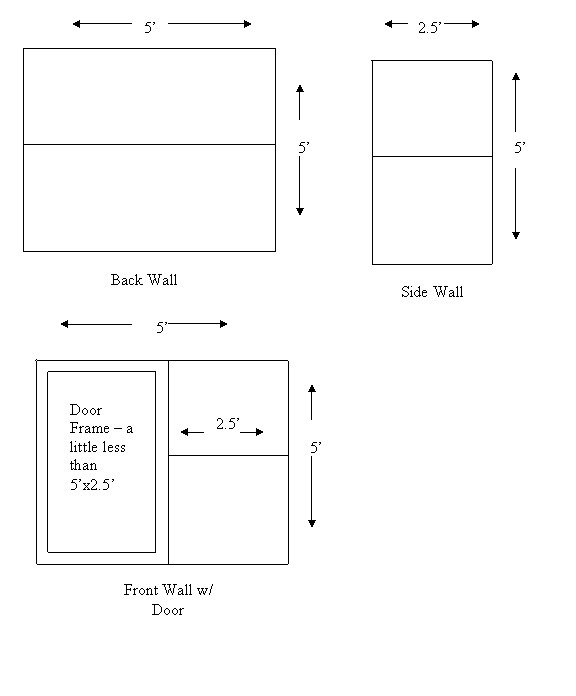 |
 |
|||||||
|
|
PVC Cage Plans 2
© 2002 Meredith Martin Parts List 11 – 1” PVC pipes 20 – 1” PVC elbows 10 – 1” PVC T-junctions 2 – 3’x15’ rolls of black plastic hardware net 1 – 3’x5’ roll of metal hardware cloth (I used the ¾” size) 1 – Heavy duty plastic tarp – at least 6’x3’ (I bough a 7’x9’ and just folded it in half for extra protection 1 – Bag of 1000 7” plastic cable ties (you won’t use all of them, but they are handy for tons of things and it is MUCH cheaper to buy them in bulk than to keep buying lots of little bags) About 70 – small sheet metal screws (optional – you can also use PVC glue to hold the joints together) Hacksaw Drill (optional – needed if using screws) 1 – 6’ x 12” plastic coated wire closet shelf 1 – plastic coated wire Laundry Shelf These plans will make a cage roughly 5’ tall, 5’ long, and 2.5’ deep. To make it larger or smaller, simply adjust the size of the PVC pipes. This cage is made in panels – front, back, 2 sides – that are then connected to each other with cable ties. It makes it easier to break it down and move/clean. The 10’ PVC pipes need to be cut down to varying sizes. The following sizes are approximate – if you want the cage EXACTLY 5x5x2.5 you will need to shorten the measurements a bit to allow for the extra length added by the connectors. Front Wall- 1- 5’ pipe 9 – 2.5’ pipes The 5’ pipe makes the left hand side of the wall. Connect 2 of the 2.5’ pipes using a T connector to make the top, and repeat for the right hand side, bottom, and middle support. Connect the last two 2.5’ pipes with a T connector to make the center support. Use elbow connectors to attach all 4 sides to each other, and connect the center support to the T connectors in the middle of the top and bottom. Then attach the last 2.5’ pipe between the center support and the right hand wall. Back Wall – 3- 5’ pipes 4 – 2.5’ pipes The 5’ pipes make the top, bottom, and center support of the wall. Connect two 2.5’ pipes with a T connector to create the right side, and repeat for the left side. Use elbows and the T connectors to attach the top, bottom, sides, and center support. Side Walls – 14 – 2.5’ pipes For each wall, connect two 2.5’ pipes with T connectors to create the tall sides, then use the elbows and the T connectors in the side walls to attach the top, bottom, and center supports. Door – When you have assembled the front wall, measure inside the door frame (making sure all the pipes are firmly seated in the connectors) to get your height and width measurements for the door. Remember that the connectors will add some length to your measurements, so you will have to allow for that. Once you have measured, cut your PVC to size and assemble using elbow connectors. Securing the joins – You may want to secure the pipes to their connectors to prevent any from popping out. You can purchase PVC glue at any hardware store such as Home Depot and glue the pipes into the connectors. Another option – and the one I used) was to drill small holes through the pipes where they overlap the connectors, and use small sheet metal screws to secure them together. I prefer this option, because if I ever need to COMPLETELY disassemble it, I can do so. The following diagrams show what the panels will look like when the PVC is assembled:
Once your frame panels are assembled, it is time for the tedious part, attaching the mesh to the frames. Lay the panels flat, and unroll the plastic mesh over them. Start at one end, and use the plastic cable ties every few inches to secure the mesh to the PVC frame. Try not to overlap the PVC too much with the mesh on the top and bottom, as you don’t want to run out of mesh. Trim excess mesh, and repeat for all panels. Remember to leave the doorway open on the front panel! ;) When all the panels (and door!) are covered with mesh, it is time to assemble the cage! Lay the tarp down on the floor where you want the cage to go. Begin by using cable ties to attach the side walls to the back wall. This was a bit tricky…loop one cable tie around the PVC side of the back wall, do not pull it tight. Next, loop one around the PVC side of the side wall at about the same height, and thread it through the loop on the back wall so that they are connected. Repeat all the way down the wall, about 6” apart. It is easiest to leave them loose until you are done, and then pull them all tight. That way you have room to work. Repeat for the second side, and for the front. Your basic frame should now be complete. Next, unroll the metal hardware cloth over the top of the frame, and secure with cable ties. Last, use the same method we used to attach the walls to each other, and attach ONE SIDE of the door to the door frame. You may also want to attach it to the top frame with one cable tie in the corner to keep it level. The door should swing open and closed easily. I use Velcro cable ties to secure it. Last, the basking shelf and ramp. I hit the closet organization section of Home Depot and got a Laundry Shelf for basking, and used a 6’ length of shelf for the ramp. Position the Laundry Shelf where you want it and attach with those oh-so-handy cable ties. Then position your ramp and secure. That’s it! If you wish, you can attach the tarp to the frame by poking holes in it and attaching with….you guessed it! – Cable ties! Add your basking light, UVB light, and any other cage fixtures/decorations, and you are done! Let your Ig enjoy his new home. It's important to keep in mind that this cage is designed for either outdoor sunning, or for a dedicated reptile room where it is easier to control heat and humidity. If you are planning to have this as an indoor cage, it is best to enclose the cage to keep in heat and humidity. Plywood, plexiglass, or even cheap shower curtains can be used to modify this cage for use in a normal household setting. Total cost for a cage this size was roughly $100. |
|
||||||
© 2002 - PurpleDragon Website Design
